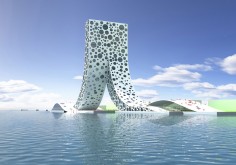BIG Architects
ren-the people building

source: arch2o
The REN building is a proposal for a hotel, sports and conference center for the World Expo 2010 in Shanghai. The building is conceived as two buildings merging into one. The first building, emerging from the water, is devoted to the activities of the body, and houses the sports and water culture center. The second building emerging from land, is devoted o tthe spirit and enlightenment, and houses the conference center. The two buildings meet in a 1000 room hotel, a building for living.
Together the two buildings become a tower and an arch at once. The arch covers a square for gatherings and activities, exactly on the main axis of the expo site overlooking the Huangpu River. The square is sheltered from the rain, but allows the sunlight through, from east in the morning and from west in the evening.
Large curved plazas cover the pool and conference buildings, creating a continuous recreational public space along the river. Round openings and roof lights bring light to the auditoriums and pools, and become gradually denser as they rise from the river, eventually becoming glittering windows and terraces for the hotel rooms. The REN building could be the Eiffel Tower of Shanghai, a landmark symbolizing the people oriented pursuit of the Shanghai Expo 2010.
.
.
.
.
.
.
.
source: bigdk
BIG is a Copenhagen and New York based group of architects, designers, builders, and thinkers operating within the fields of architecture, urbanism, interior design, landscape design, product design, research and development. The office is currently involved in a large number of projects throughout Europe, North America, Asia and the Middle East. BIG’s architecture emerges out of a careful analysis of how contemporary life constantly evolves and changes. Not least due to the influence from multicultural exchange, global economical flows and communication technologies that all together require new ways of architectural and urban organization. We believe that in order to deal with today’s challenges, architecture can profitably move into a field that has been largely unexplored. A pragmatic utopian architecture that steers clear of the petrifying pragmatism of boring boxes and the naïve utopian ideas of digital formalism. Like a form of programmatic alchemy we create architecture by mixing conventional ingredients such as living, leisure, working, parking and shopping. By hitting the fertile overlap between pragmatic and utopia, we architects once again find the freedom to change the surface of our planet, to better fit contemporary life forms.

